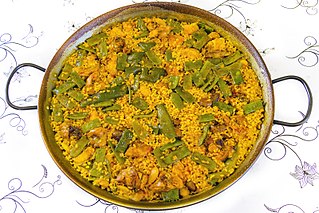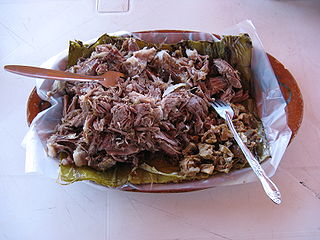
Pizza is a dish of Italian origin consisting of a usually round, flat base of leavened wheat-based dough topped with tomatoes, cheese, and often various other ingredients, which is then baked at a high temperature, traditionally in a wood-fired oven. A small pizza is sometimes called a pizzetta. A person who makes pizza is known as a pizzaiolo.

Paella is a rice dish originally from Valencia. While it is commonly viewed by non-Spaniards as Spain's national dish, Spaniards almost unanimously consider it to be a dish from the Valencian region. Valencians, in turn, regard paella as one of their identifying symbols. It is one of the best-known dishes in Spanish cuisine.

Tempura is a typical Japanese dish usually consisting of seafood, meat and vegetables that have been battered and deep fried. The dish was introduced by the Portuguese in Nagasaki through the fritter-cooking techniques in the 16th century. The word ‘tempura’ comes from the Latin word tempora, a term referring to these times of fasting, when the church dictated that Catholics go meatless.
Gringo (masculine) is a term in Spanish and Portuguese for a foreigner, usually an English-speaking Anglo American. There are differences in meaning depending on region and country. In Latin America, it is generally used to refer to non-Latin Americans. The term is often considered disparaging in English, and in the United States its usage and offensiveness is disputed.

A fajita, in Tex-Mex cuisine, is any stripped grilled meat with stripped peppers and onions usually served on a flour or corn tortilla. The term originally referred to skirt steak, the cut of beef first used in the dish. Popular alternatives to skirt steak include chicken and other cuts of beef, as well as vegetables instead of meat. In restaurants, the meat is usually cooked with onions and bell peppers. Popular condiments include shredded lettuce, sour cream, guacamole, salsa, pico de gallo, shredded cheese, refried beans, and diced tomatoes. Arrachera is a northern Mexican variant of the dish.

Frankincense is an aromatic resin used in incense and perfumes, obtained from trees of the genus Boswellia in the family Burseraceae. The word is from Old French franc encens.

Pademelons are small, furry, hopping mammals in the genus Thylogale, found in Australia and New Guinea. They are some of the smallest members of the macropod family (Macropodidae), which includes the similar-looking but larger kangaroos and wallabies. Pademelons are distinguished by their small size and their short, thick, and sparsely-haired tails. Like other marsupials, they carry their young in a pouch.

Bixa orellana, also known as achiote, is a shrub native to Central America. Bixa orellana is grown in many countries worldwide.
Flexitarianism or Flexitarism is a semi-vegetarian diet in which people do not eat meat one or more days a week, just like the majority of human carnivores.

A pedant is a person who is excessively concerned with formalism, accuracy and precision, or one who makes an ostentatious and arrogant show of learning.

Barbacoa is a form of cooking meat that originated in the Caribbean with the Taíno people, who called it by the Arawak word barbaca, from which the term "barbacoa" derives, and ultimately, the word 'barbecue". In contemporary Mexico, it generally refers to meats or whole sheep or whole goats slow-cooked over an open fire or, more traditionally, in a hole dug in the ground covered with agave (maguey) leaves, although the interpretation is loose, and in the present day may refer to meat steamed until tender. This meat is known for its high fat content and strong flavor, often accompanied with onions and cilantro.

Borek or burek is a filled Anatolian, Balkan, Middle Eastern and Central Asian pie made of a thin flaky dough such as filo with a variety of fillings, such as meat, cheese, spinach or potatoes. Boreks are mainly associated with the areas of the Anatolia, Middle East, Armenia, and also with the former Ottoman Empire, including the Balkans and the Caucasus, Eastern European and Central European countries, Northern Africa and Central Asia. A borek may be prepared in a large pan and cut into portions after baking, or as individual pastries. They are usually baked but some varieties can be fried. Borek is sometimes sprinkled with sesame or nigella seeds, and it can be served hot or cold.

The swallow-tailed gull is an equatorial seabird in the gull family, Laridae. It is the only species in the genus Creagrus, which derives from the Latin Creagra and the Greek kreourgos which means butcher, also from kreas, meat; according to Jobling it would mean "hook for meat" referring to the hooked bill of this species. It was first described by French naturalist and surgeon Adolphe-Simon Neboux in 1846. Its scientific name is originally derived from the Greek word for gull, "Glaros" and via Latin Larus, "gull" and furca "two-tined fork". It spends most of its life flying and hunting over the open ocean. The main breeding location is in the Galápagos Islands, particularly the rocky shores and cliffs of Hood, Tower and Wolf Islands, with lower numbers on most of the other islands. It is more common on the eastern islands where the water is warmer.

Escabeche is the name for a number of dishes in Spanish, Portuguese, Filipino and Latin American cuisines, consisting of marinated fish, meat or vegetables, cooked in an acidic sauce, and colored with paprika, citrus, and other spices.

Picadillo is a traditional dish in many Latin American countries and the Philippines. It is made with ground meat, tomatoes, and also raisins, olives, and other ingredients that vary by region. It is often served with rice or used as a filling in dishes such as tacos, savory pastries or croquettes. The name comes from the Spanish word picar, meaning "to mince".
Pastel is the Spanish and Portuguese word for pastry, a sugary food, and is the name given to different typical dishes of various countries where those languages are spoken. In Mexico, pastel typically means cake, as with Pastel de tres leches. However, in different Latin American countries pastel can refer to very different sugary dishes, and even to non-sugary ones as well. In some places, like Brazil, a pastel can refer to both a sugary and non-sugary food, depending on the filling used.
Kocuria is a genus of gram-positive bacteria. Kocuria is named after Miroslav Kocur, a Slovakian microbiologist. It has been found in the milk of water deer and reindeer. Cells are coccoid, resembling Staphylococcus and Micrococcus, and can group in pairs, chains, tetrads, cubical arrangements of eight, or irregular clusters. They have rigid cell walls and are either aerobic or facultative anaerobic. Kocuria can usually survive in mesophilic temperatures.

Snails are considered edible in certain areas such as the Mediterranean region, Africa, or Southeast Asia, while in other cultures it is considered as taboo food. In American English, edible land snails are also called escargot, taken from the French word for 'snail', and the production of snails for consumption is called snail farming or heliciculture. Snails as food date back to ancient times, and it was a dish that was already served on the tables of Ancient Greece and Rome.
Kocuria indica is a species of bacteria in the genus Kocuria.
Kocuria varians is a gram-positive species of bacteria in the genus Kocuria. It has been isolated from milk, meat, skin, soil, and beach sand. It is 0.9 to 1.5 micrometers in diameter, and occurs in clusters, which can be up to 4 millimeters in diameter and are yellow. It is known to cause ocular infections, brain abscesses, and endophthalmitis.













